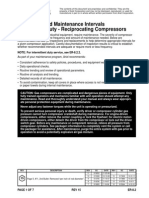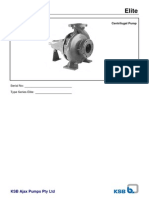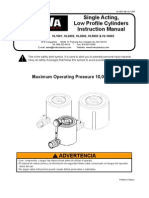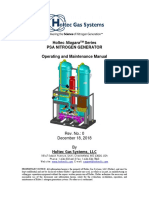Catalytic Converter and Exhaust Back Pressure
Catalytic Converter and Exhaust Back Pressure
Uploaded by
eiochoaCopyright:
Available Formats
Catalytic Converter and Exhaust Back Pressure
Catalytic Converter and Exhaust Back Pressure
Uploaded by
eiochoaCopyright
Available Formats
Share this document
Did you find this document useful?
Is this content inappropriate?
Copyright:
Available Formats
Catalytic Converter and Exhaust Back Pressure
Catalytic Converter and Exhaust Back Pressure
Uploaded by
eiochoaCopyright:
Available Formats
INSTRUCTIONS FOR:
CATALYTIC CONVERTER BACK PRESSURE
TEST KIT
MODEL No: VSE953
Thank you for purchasing a Sealey product. Manufactured to a high standard this product will, if used according to these instructions
and properly maintained, give you years of trouble free performance.
IMPORTANT: PLEASE READ THESE INSTRUCTIONS CAREFULLY. NOTE THE SAFE OPERATIONAL REQUIREMENTS, WARNINGS AND CAUTIONS.
USE THE PRODUCT CORRECTLY AND WITH CARE FOR THE PURPOSE FOR WHICH IT IS INTENDED. FAILURE TO DO SO MAY CAUSE DAMAGE
AND/OR PERSONAL INJURY AND WILL INVALIDATE THE WARRANTY. PLEASE KEEP INSTRUCTIONS SAFE FOR FUTURE USE.
IMPORTANT: Always refer to the vehicle manufacturer’s service instructions, or proprietary manual to establish the current procedure and
data.These instructions are provided as a guide only.
Ensure all Health and Safety, local authority, and general workshop practice regulations are strictly adhered to when using product.
Maintain tools in good and clean condition for best and safest performance. DO NOT use test kit if damaged.
Account for all tools and parts being used and do not leave them in, or on the engine after use.
Ensure you have read and understood the safety aspects of dealing with the fuel injection system and petrol in general before commencing.
Personal / Operation
Wear approved eye protection. A full range of personal safety equipment is available from your Sealey dealer.
Keep yourself, clothing and test equipment away from all moving or hot engine parts.
Do not wear jewellery and tie back long hair.
Before performing a test with the engine running (unless the manufacturer's manual states otherwise), set the parking brake and place the
gear selector in neutral or park, and block the drive wheels.
Exhaust gas contains deadly poisonous gases. The test area must be well ventilated - route the exhaust gas outdoors.
2. INTRODUCTION AND SPECIFICATION
Used to establish the working condition of the catalytic converter and silencer by measuring the relative back pressure of the system. Simply
connect into the exhaust system using either of the two oxygen sensor dummy adaptors supplied in the kit. Gauge features a colour coded scale
for easy diagnosis and reads both pressure and vacuum so can be used on other areas of the vehicle allowing testing of low pressure fuel systems
or engine vacuum. Supplied with gauge hanging chain to allow hands free operation.
Model No:. . . . . . . . . . . . . . . . . . VSE953
Contents:. . . . . . . . . . . . . . . . . . Oxygen Sensor Adaptors M12x1.25, M18x1.5
Small & Large Brass Cone Adapters
Plastic Double Ended Cone
Plastic 'T' Piece
Gauge Hanging Chain
Gauge Scale:. . . . . . . . . . . . . . . Pressure 0-10psi
Vacuum 0-60cmHg
3. OPERATION
3.1. TESTING THROUGH THE OXYGEN SENSOR PORT
Note: See section 4 for part numbers and description of each item.
WARNING! Exhaust systems can get very hot and testing should be carried out when the engine is cold to avoid injury (burns) and
so the rubber hose on the tool does not get too hot and distort. Testing should be completed within 5 minutes of the engine being
started from cold. Allow the engine to cool before removing the Oxygen sensor adaptors because these will be very hot and could
cause injury.
Note: Before replacing any suspected blocked exhaust components ALWAYS refer to the vehicle manufacturer's specifications to
obtain the correct pressure limits.
Note: Disconnecting the Oxygen sensor or running the engine with the sensor disconnected may cause the vehicle to illuminate
the MIL (Malfunction Indicator Light) which will require an EOBD diagnostic tool to reset it.
3.1.1. If there are two or more oxygen sensors, start testing at the one nearest the engine and proceed 'downstream'. Disconnect the oxygen
sensor wires and remove the oxygen sensor.
3.1.2. Install the oxygen sensor adaptor (refer to section 4).
3.1.3. Connect the rubber hose and gauge (see fig.1) onto the oxygen sensor adaptor.
3.1.4. Start the engine and allow it to idle, the reading should not register over 1psi in the Green scale. If the gauge registers over this pressure,
stop the engine, locate the restriction and correct the fault (see 3.2).
3.1.5. If the idle reading is NOT above 1psi, rev the engine to 2500rpm. The reading should not register over 2.5psi, if the gauge registers over this
pressure, stop the engine, locate the restriction and correct the fault (see 3.2)
3.1.6. If the vehicle has more than one exhaust pipe, with two catalytic converters, each will need to be checked.
3.2. TESTING THE CATALYTIC CONVERTER
3.2.1. If a blocked catalytic converter is suspected, test again after the converter using the second oxygen sensor (post cat) port. If the
converter is blocked the gauge will read a lower pressure than the first sensor (pre cat) port. For example, if the first oxygen sensor port
reads 4psi and the second oxygen sensor reads 0.5psi, this shows a blocked catalytic converter.
3.3. TESTING VEHICLES WITHOUT OXYGEN SENSORS
3.3.1. If the vehicle isn't fitted with oxygen sensors or they can't be removed it is possible to drill a small hole in the side of the exhaust pipe, (away
from any welds and NOT into the catalyst), and use one of the brass cone adaptors (see section 4.6 and 4.7) to obtain a reading. After
testing the small hole will require filling with either a small self tapping screw or weld.
© Jack Sealey Limited Original Language Version VSE953 Issue 1 - 19/06/13
3.4 VACUUM TEST
3.4.1. Use the supplied adaptors (see section 4.4, 4.5) to connect gauge as close to the inlet manifold as possible, ensure that the hose is not
kinked.
Should an engine have two inlet manifolds carry out separate tests on each manifold.
3.4.2. Start engine, if required adjust idle speed to obtain a smooth tick over. If the gauge needle remains steady with a reading between 43 and
55cmHg, the engine is in good condition.
3.4.3. If the gauge drops back about 10cmHg on the dial, this would indicate sticky valves. Disconnect the vacuum hose and spray penetration oil
into the manifold to lubricate the valves.
3.4.4. If the needle consistently drops, this would indicate that the valve clearances are too tight or that a valve has burnt out.
3.4.5. If the needle pulsates rapidly when the rpm is increased, this indicates that valve springs may be weak.
3.4.6. If the needle pulsates rapidly at idle, and steadies out when the rpm is increased, this indicates that the valve guides are worn or loose.
3.4.7. If the needle is slow to drop back after engine rpm has been increased several times in sucession, this would indicate that the exhaust
system may be partially blocked.
3.4.8. If the gauge indicates less than 25cmHg, this would indicate that the valve timing is late.
3.4.9. To check the choke, close the throttle and turn the engine over using the starter motor, the gauge should rise quickly to 55cmHg. If the gauge
remains at a low reading or 7 to 15cmHg then the throttle may not be fully closed or there may be an air leak in the inlet manifold.
Note: Gauge readings will vary with altitude, at sea level the vacuum gauge will drop by 2.5cmHg. For instance at 2000ft the reading will be
44cmHg.
4. CONTENTS / PARTS NUMBER LIST
Fig.1
Part Part No. Description
1. VSE953.01 Gauge
2. VSE953.06 Oxygen sensor adaptor M12x1.25
3. VSE953.05 Oxygen sensor adapter M18x1.5
4. VSE953.04 Plastic double ended cone
5. VSE953.09 Plastic T piece
6. VSE953.08 Large brass cone adapter
7. VSE953.07 Small brass cone adapter
8. VSE953.03 Hose
9. VSE953.02 Gauge hanging chain
Environmental Protection.
Recycle unwanted materials instead of disposing of them as
waste. All tools, accessories and packaging should be sorted,
taken to a recycle centre and disposed of in a manner which
is compatible with the environment.
Parts support is available for this product. To obtain a listing and/or diagram, please log on to: www.sealey.co.uk,
email: sales@sealey.co.uk or phone: 01284 757500
NOTE: It is our policy to continually improve products and as such we reserve the right to alter data, specifications and component parts without prior notice.
IMPORTANT: No liability is accepted for incorrect use of this product.
WARRANTY: Guarantee is 12 months from purchase date, proof of which will be required for any claim.
INFORMATION: For a copy of our latest catalogue and promotions call us on 01284 757525 and leave your full name and address, including postcode.
Sole UK Distributor, Sealey Group, 01284 757500 www.sealey.co.uk
Kempson Way, Suffolk Business Park, Web
Bury St. Edmunds, Suffolk,
IP32 7AR 01284 703534 email sales@sealey.co.uk
© Jack Sealey Limited Original Language Version VSE953 Issue 1 - 19/06/13
You might also like
- Vespa GTS Super 125 I.E. (En)Document285 pagesVespa GTS Super 125 I.E. (En)ManuallesNo ratings yet
- Cylinder Leakage Tester 2 - Gauge Vse2020.V3: 1. SafetyDocument2 pagesCylinder Leakage Tester 2 - Gauge Vse2020.V3: 1. Safetyhotmaail4No ratings yet
- Vse952 DFC0166998Document2 pagesVse952 DFC0166998ابوفاطمةاليساريNo ratings yet
- MODEL No: VS211.V2: Fuel Injector Test Device 12V - PetrolDocument3 pagesMODEL No: VS211.V2: Fuel Injector Test Device 12V - Petrolnicolae_popescu_18No ratings yet
- VSE2020.V2: Cylinder Leakage TesterDocument2 pagesVSE2020.V2: Cylinder Leakage Testerwalson glen CrastaNo ratings yet
- Diesel Injector Flow Test Set (Bosch Common Rail) VS2046: 1. Safety InstructionsDocument2 pagesDiesel Injector Flow Test Set (Bosch Common Rail) VS2046: 1. Safety InstructionsHERMAWAN100% (1)
- VS200.V2 SealeyDocument2 pagesVS200.V2 SealeyaudioimagenNo ratings yet
- 3 Service Manuals GTR250 0420Document159 pages3 Service Manuals GTR250 0420timawade100% (1)
- universal-propeller-water-current-meterDocument18 pagesuniversal-propeller-water-current-meternathansta61No ratings yet
- VS2050Document2 pagesVS2050ΜΠΑΜΠΗΣ ΛΙΑΤΟΣNo ratings yet
- MR 5-30 or MR 5-30N Series Fuel Meter Owner's ManualDocument8 pagesMR 5-30 or MR 5-30N Series Fuel Meter Owner's ManualTuấn VũNo ratings yet
- Apeks Tx100 1st Stage Service ManualDocument18 pagesApeks Tx100 1st Stage Service Manualarnaud_erhartNo ratings yet
- Holley Carb AdjustmentsDocument8 pagesHolley Carb AdjustmentsAaron SteeleNo ratings yet
- Heed 3 Tech Manual 2013Document4 pagesHeed 3 Tech Manual 2013mecambNo ratings yet
- Vdocuments.site Gamax Atv Ax600600lx BwDocument257 pagesVdocuments.site Gamax Atv Ax600600lx BwpamposNo ratings yet
- Click Wrench RepairDocument31 pagesClick Wrench RepairTu PhamNo ratings yet
- Fuel Injection Nozzle - Test: Shutdown SIS Previous ScreenDocument6 pagesFuel Injection Nozzle - Test: Shutdown SIS Previous ScreenbejoythomasNo ratings yet
- I08-0740 Instructions 2022 v1.5 WebDocument1 pageI08-0740 Instructions 2022 v1.5 WebLeandro CaraccioliNo ratings yet
- OSSB1 Manual1Document22 pagesOSSB1 Manual1Jaypee EvangelistaNo ratings yet
- Catalogo Control ContaminantesDocument132 pagesCatalogo Control ContaminantesJose Jaramillo50% (2)
- Oil PumpDocument12 pagesOil Pumpmatovu bernardNo ratings yet
- OT-60 Oil Insulation Dielectric Tester ManualDocument15 pagesOT-60 Oil Insulation Dielectric Tester ManualMikhail YudhiantaraNo ratings yet
- SIP T2300 Generator ManualDocument8 pagesSIP T2300 Generator ManualMatt Robinson100% (1)
- 1" Mechanical Fuel Meter: User'S ManualDocument7 pages1" Mechanical Fuel Meter: User'S ManualENT ENTNo ratings yet
- Engine Tune-Up: Ii. Tools and MaterialsDocument6 pagesEngine Tune-Up: Ii. Tools and MaterialsdrakuleeNo ratings yet
- Trace Analytics AirCheck Kit K8573NB Sampling Instructions V8 PDFDocument22 pagesTrace Analytics AirCheck Kit K8573NB Sampling Instructions V8 PDFHassan Houdoud100% (1)
- Cdi Troubleshooting Guide Johnson EvinrudeDocument35 pagesCdi Troubleshooting Guide Johnson EvinrudeEvan CollinsNo ratings yet
- Packet H Chain SawsDocument8 pagesPacket H Chain SawsForum PompieriiNo ratings yet
- Owner's Manual & Safety InstructionsDocument4 pagesOwner's Manual & Safety Instructionsericokada88No ratings yet
- ARIEL Maint intervalSEK PDFDocument7 pagesARIEL Maint intervalSEK PDFMargaret Daugherty100% (1)
- Pump-Elite - Operating InstructionsDocument12 pagesPump-Elite - Operating Instructionsbookslover1No ratings yet
- Gast 23 Series Oilless ManualDocument8 pagesGast 23 Series Oilless Manualclangbird210No ratings yet
- Unit Ii Inspection of Piston EngineDocument45 pagesUnit Ii Inspection of Piston Engineraj6062No ratings yet
- Braking System r1300Document23 pagesBraking System r1300Jarrod DebonoNo ratings yet
- Proceso de Mantenimiento Maquina AnestesiaDocument20 pagesProceso de Mantenimiento Maquina AnestesiaSHIRLEY GIRALDONo ratings yet
- TE50 Service ManualDocument133 pagesTE50 Service ManualJeferson SilvaNo ratings yet
- SR4 Generator & Control Panel MaintenanceDocument7 pagesSR4 Generator & Control Panel MaintenancejavierNo ratings yet
- Maintenance ScheduleDocument16 pagesMaintenance ScheduleSiska0806No ratings yet
- Manual General Taller Motos Keeway 50cc (Idioma Ingles)Document64 pagesManual General Taller Motos Keeway 50cc (Idioma Ingles)CordobessaNo ratings yet
- 1zua5492-505 - Gas Detector Relay Model 11 and 12Document16 pages1zua5492-505 - Gas Detector Relay Model 11 and 12Hau Phung VanNo ratings yet
- Single Acting, Low Profile Cylinders Instruction Manual: Maximum Operating Pressure 10,000 PSIDocument8 pagesSingle Acting, Low Profile Cylinders Instruction Manual: Maximum Operating Pressure 10,000 PSITitanplyNo ratings yet
- Diesel Engine Compression Tester: Item 93644Document8 pagesDiesel Engine Compression Tester: Item 93644ahmed_eng_1500No ratings yet
- 3306 Industrial Engine 64Z05381-UP (SEBP1989 - 33) - Sistemas y ComponentesDocument15 pages3306 Industrial Engine 64Z05381-UP (SEBP1989 - 33) - Sistemas y ComponentesLynda Carroll100% (2)
- TSI Alnor VelociCalc 9515 ManualDocument16 pagesTSI Alnor VelociCalc 9515 ManuallizarazojavierNo ratings yet
- General Information - Standard Workshop PracticesDocument6 pagesGeneral Information - Standard Workshop PracticesJim LiebNo ratings yet
- Diesel High Pressure Pump Test Kit: 1. SafetyDocument4 pagesDiesel High Pressure Pump Test Kit: 1. SafetyVladimirAgeevNo ratings yet
- J1415 Omm R0 PDFDocument34 pagesJ1415 Omm R0 PDFCarlos MagNo ratings yet
- Gammon Contamination Test Kits PDFDocument3 pagesGammon Contamination Test Kits PDFpersadanusantaraNo ratings yet
- 1986 1989 Fourtrax Foreman 350Document303 pages1986 1989 Fourtrax Foreman 350mike.hickman100% (1)
- Masoneilan 87-88 SeriesDocument28 pagesMasoneilan 87-88 SeriesalexmartbaNo ratings yet
- ZT 6000 VSDocument14 pagesZT 6000 VSdesign_artNo ratings yet
- GM Automatic Overdrive Transmission Builder's and Swapper's GuideFrom EverandGM Automatic Overdrive Transmission Builder's and Swapper's GuideRating: 4.5 out of 5 stars4.5/5 (8)
- Installation and Operation Instructions For Custom Mark III CP Series Oil Fired UnitFrom EverandInstallation and Operation Instructions For Custom Mark III CP Series Oil Fired UnitNo ratings yet
- How to Build & Power Tune Distributor-type Ignition Systems: New 3rd Edition!From EverandHow to Build & Power Tune Distributor-type Ignition Systems: New 3rd Edition!No ratings yet
- Stories from the Road 3: An Automotive Case Studies SeriesFrom EverandStories from the Road 3: An Automotive Case Studies SeriesNo ratings yet
- Automotive Sensor Testing and Waveform AnalysisFrom EverandAutomotive Sensor Testing and Waveform AnalysisRating: 4.5 out of 5 stars4.5/5 (14)
- Diesel Engine Care and Repair: A Captain's Quick GuideFrom EverandDiesel Engine Care and Repair: A Captain's Quick GuideRating: 5 out of 5 stars5/5 (1)
- Soil Mechanics Activities and AssessmentsDocument6 pagesSoil Mechanics Activities and AssessmentsbrandonNo ratings yet
- Mec 124 ND Yr Ii Ee Machine ToolsDocument1 pageMec 124 ND Yr Ii Ee Machine Toolsmas ud dan jigaNo ratings yet
- Adaptive DriveDocument8 pagesAdaptive DriveYun ZhenNo ratings yet
- Test Plugs: Complete Line of Low, Medium & High PressureDocument16 pagesTest Plugs: Complete Line of Low, Medium & High PressureAnonymous EvAY5nSdNo ratings yet
- Articulo JMC2015Document9 pagesArticulo JMC2015A.s. BezmalinovićNo ratings yet
- Technical Specification For Motor Operated ValvesDocument6 pagesTechnical Specification For Motor Operated ValvesĐặng Trung AnhNo ratings yet
- PG Dial Governor Back Pressure Controller: Operation ManualDocument12 pagesPG Dial Governor Back Pressure Controller: Operation ManualrNo ratings yet
- 2022 - Petrochem - Delegation - Company Profiles - 13.10.Document8 pages2022 - Petrochem - Delegation - Company Profiles - 13.10.Santosh KatkarNo ratings yet
- Euler Column Theory PDFDocument2 pagesEuler Column Theory PDFDeeNo ratings yet
- Connection 1Document17 pagesConnection 1Der3'am Al m7armehNo ratings yet
- Linear MotionDocument9 pagesLinear MotionShanti Thanarajan33% (3)
- How To Read PEFs DrawingDocument20 pagesHow To Read PEFs DrawingEmmanuel Ezekiel-Hart EdemNo ratings yet
- Review Module - Working Stress DesignDocument1 pageReview Module - Working Stress DesignDream CatcherNo ratings yet
- PP30 Operation Manual FILE-004209Document41 pagesPP30 Operation Manual FILE-004209salil bangaleNo ratings yet
- Notification APTRANSCO Asst Engineer PostsDocument11 pagesNotification APTRANSCO Asst Engineer PostsRohitRajakNo ratings yet
- Pile Capacity Report: TCVN 10304 - 2012Document2 pagesPile Capacity Report: TCVN 10304 - 2012Le Trong NhanNo ratings yet
- An Overview of Automobile Noise and Vibration ControlDocument11 pagesAn Overview of Automobile Noise and Vibration ControlMathews P Reji100% (1)
- Vigas Metalicas de Pontes ProtendidasDocument298 pagesVigas Metalicas de Pontes Protendidasjose airton chrisostomoNo ratings yet
- Inconel 600 Alloy 600 Uns n06600 Din 2.4816Document3 pagesInconel 600 Alloy 600 Uns n06600 Din 2.4816SamkitNo ratings yet
- FESTO Basic PnuematicsDocument114 pagesFESTO Basic Pnuematicschoonhooi100% (1)
- GM Reference Only Catalog PDFDocument11 pagesGM Reference Only Catalog PDFLuisYFer1No ratings yet
- WRSV 5 10E Safety Valve Data SheetDocument1 pageWRSV 5 10E Safety Valve Data SheetArturo Treviño MedinaNo ratings yet
- Orifice Uncertainty - Immis 1 - DENSITOMETERDocument1 pageOrifice Uncertainty - Immis 1 - DENSITOMETERabdulhalimbinamrinNo ratings yet
- Serway R.a., Jewett J.W. - Physics For Scientists and Engineers With Modern Physics-Brooks Cole (2009)Document3 pagesSerway R.a., Jewett J.W. - Physics For Scientists and Engineers With Modern Physics-Brooks Cole (2009)SynmaryNo ratings yet
- Final Truss ProjectDocument11 pagesFinal Truss Projectapi-534992889No ratings yet
- Catalogo Chumaceras RHP InoxidableDocument16 pagesCatalogo Chumaceras RHP InoxidableJosias Velasquez CotradoNo ratings yet
- Exp1 (Final) PDFDocument15 pagesExp1 (Final) PDFZaidNo ratings yet
- 90 Encendido Toyota 5vz-FeDocument5 pages90 Encendido Toyota 5vz-Fejorge rioboNo ratings yet
- SEC 5 SM-BC Conjugate Beam MethodDocument3 pagesSEC 5 SM-BC Conjugate Beam MethodFletcherAlLataganNo ratings yet
- Chillers Screw ScrollDocument8 pagesChillers Screw ScrollAhmed Mohamed AliNo ratings yet

























































































